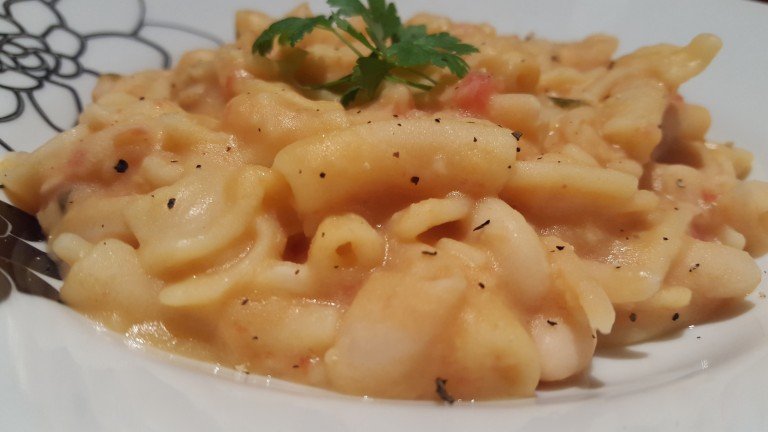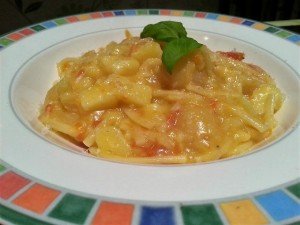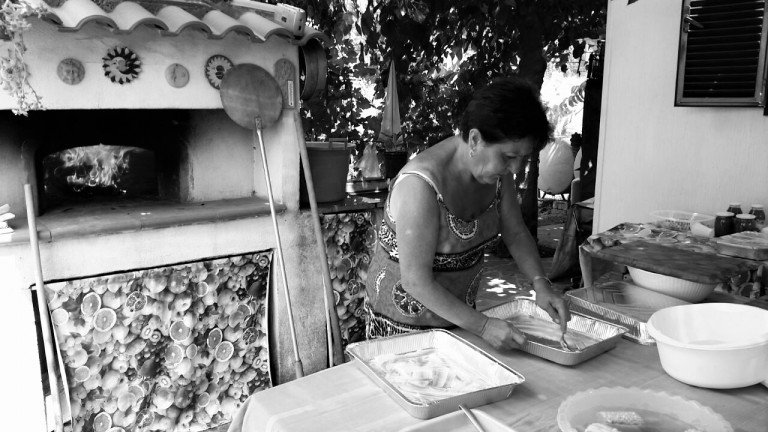
I could not resist. What better introduction to pasta e fagioli than this legendary song? Who hasn’t sung it in the kitchen, dancing along in the arms of your partner, or dog/cat/rabbit? As cheesy as it might be, any time this song is on the radio and we happen to be in the kitchen, my husband and I will start singing out loud and won’t stop dancing until the end of the song.
But most importantly… who doesn’t like beans? And, because of their nutritious value, who hasn’t been fed a huge amount when a child? Also, who could forget the “Beans, beans, they’re good for your heart/the musical fruit” song? Right – enough. Clearly, beans = music and romance. Fact.
I am well accustomed to the British tradition of beans on toast: cheap and tasty, they are popular among students on a very restricted budget during the university years. But in Italy they are not just loved by people; they are adored – especially when associated with pasta. Yes, pasta e fagioli belongs to the category I previously defined as “le mitiche” (the legends), just like pasta and patate.

Pasta e fagioli is in fact very symbolic of Neapolitan tastes: we love simple, fresh, nutritious and tasty food. It really does not take much to be happy, and Neapolitans know a lot about that when it comes to the table.

It might be an idyllic view, but while I was growing up, going out with friends would often mean going for a pizza, or to a trattoria – not going to a bar for drinks. Food played and still plays a big role in the happiness of so many people.



Ingredients for pasta e fagioli
Serves 4
- 400g dry cannellini or butter or haricot beans (or 800g of canned beans: follow method from the “cooking the beans and pasta” heading)
- 300g pasta mista (or broken spaghetti or tubettoni pasta)
- 2-3 tablespoons of chopped tomatoes from a can
- 2 garlic cloves, crushed
- 4 tablespoons extra-virgin olive oil
- Salt
- About 600ml water
Extra
- Pepper
- Small bunch of fresh parsley
- 1 bay leaf (for the soaking process)
- 1 garlic clove (for the soaking process)
Method
Because this is a time-consuming process, I recommend you cook a larger quantity of dry beans than the recipe requires and freeze the extra to use next time.
Soaking the beans
The night before cooking, fill a large, deep saucepan with cold water. Add the dry beans, a garlic clove and a laurel leaf and let them soak until the next morning. The beans will expand, so make sure you use a large pan.
This will allow them to cook properly, and more quickly, the next day.
Cooking the beans
Drain the beans in a colander and rinse.
Transfer to a large pan and cover with about 6cm of cold water. On medium heat, bring to the boil.
Some foam might appear. Scoop it off. Keep boiling the beans for 10 more minutes. Scoop the foam off again. Add a teaspoon of salt (but no more, as this will make their skin hard). Stir well.
Cook on low heat until it reaches a simmer. Put a lid across half the surface of the pan and cook gently for 1 to 1 1/2 hours, until tender.
Keep an eye on the water level, and add more if necessary.
When ready, drain the beans – but make sure you keep the cooking water.
Take the amount of beans required for the recipe and store the rest in the freezer (use suitable bags for freezing).
Cooking the beans with pasta
In a medium-sized pan add the oil and garlic. Sauté them on low heat until the garlic gets some colour.
Add the crushed tomatoes and stir. Add the beans, stirring them well.
Cover with 300ml water, add some salt and cook gently for up to 5 minutes, until the beans start to get even more tender. Crush some of them with a fork.
Add the rest of the water, bring to the boil, add the pasta and stir well. Add some extra boiling water if the content gets too sticky.
Cook on medium-high heat, enough to keep the boil on (as required to cook pasta properly), add some extra salt and pepper as per your taste (yes, you have to taste and adjust).
Cook for the cooking time suggested for the pasta.
When the pasta is ready, and you have a creamy, but not brothy, consistency, take off the hob and let rest for 5 minutes.
The authentic pasta e fagioli that a Neapolitan loves is creamy and a bit sticky. Any other version might be good (or even better?!), but please don’t call it pasta e fagioli napoletana, as it just is not!
Sprinkle some freshly chopped parsley on top before serving, and extra freshly ground pepper.
The next day, pasta e fagioli will be stickier and tastier. There is a test to see whether it is a real pasta e fagioli: stick a fork in it, and if it stays standing, you got it right!

Un piatto povero,semplice,ma allo stesso modo prelibato e ghiotto
Ooooi!! Yumny
This is a magical dish. Try it once and you will be one of your fav for ever!